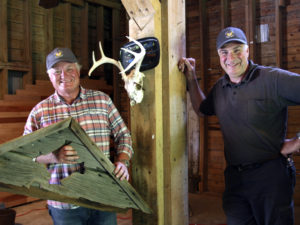Comment
Connecting history
It’s about the stories. It’s about the connections a discarded piece of wood or an iron school bell can make between people separated by generations. It’s about fusing an almost forgotten past to our lives today.
Ernie Margetson has tended a simmering passion for the old ways of rural Ontario his entire life—for the buildings, the architecture and particularly the barns that remain with us. Rural icons of a different era. A different way of life.
Perhaps it is this passion that prodded the Melville Road boy to become an engineer by trade. (Margetson currently serves as Hillier’s member of council at Shire Hall.)
He sees what others don’t. The shape and scale of the century-old barn tells the story of its use, its inspiration, and where it is likely weakening after decades of standing sturdy against wind, rain and snow. He knows when the barn fell into disuse and the economic forces that caused it to do so. We are standing in an massive old barn slated for demolition. Margetson is hoping to find a home for it, before that happens. He points to a 14-inch beam spanning the length of the long empty barn. “Have you ever seen a tree this thick and long in the County?” he asks the visitor. The timber for such construction has long ago disappeared, making this piece more precious than the casual observer will ever know.

Chris Braney (left) and Ernie Margetson at the opening of Rustico on Sunday in Wellington.
His passion clearly extends beyond the thing—to the place and time that have slipped away. Mostly unnoticed. He is trying to change that. Margetson has spent a lot of his spare time over the past couple of decades finding homes for unwanted or neglected barns. Where there is a restored barn or farm home in the County, there is a good chance he had a hand in making it happen.
Now, Margetson and fellow rural architecture enthusiast Chris Braney have created a venue to facilitate connections between our discarded history with builders, renovators and restorers who are keen to imbue their creations with these stories.
Rustico is as much an idea as it is a place buy and sell old doors, windows and distinctive architectural artifacts. The concept is captured in a lightly modified Pete Seeger lyric:
If it can’t be Reduced, Reused, Repaired, Rebuilt, Refurbished, Refinished, Resold, Recycled or Returned to the Earth, then it should be Restricted, Redesigned or Removed from Production.
Located in the old feed mill on Second Street in Wellington, the weathered wood-beamed remnant of the the village’s vibrant railwaydriven commercial era, the mill serves as a fitting backdrop for this venture. It is less a retail store—though they already have a selection of interesting artifacts—than it is an exchange or marketplace. A venue to match a growing inventory of disused barn or farm home elements scattered around the County and beyond with restoration enthusiasts eager to repurpose something genuine.
Margetson has spent much of his adult lifetime assembling this inventory in his head. He knows where it is and what it will take to put it in the hands of the customer or designer.
Where many of us see barn boards, he sees variety— colour, use and texture. Threshing board, he explains, is typically wide planks that have been worn heavily due to its use. Dust board was typically found under a hay mow. It is usually typically clean and close to original condition. Silver board is what most think of in terms of barn board—typically weather-worn after serving for decades as cladding on the outside of a barn or shed. Then there is granary board, “smooth, with a beautiful golden patina”.
Rustico takes this rich inventory—including a wide variety of farmhouse hardwood—from forgotten piles and sheds and makes them available to those seeking to restore and build in a way this is true to the materials that defined this place.
It is about the stories. Certainly, part of the motivation is to keep some of our County legacy from the landfill, but for Braney and Margetson, it is as much about keeping the stories alive.
“It inevitably provokes conversation about the history of this place, the archaeology and tells the stories of those who went before us,” explained Margetson.
He picks up a simple narrow shelf about yard long from the mill wall. Once it would have served in a rural County kitchen— perhaps propping the salt, sugar or matches to light the fire. Margetson points to the hand-crafted detail on the support blocks. The S-shape has been hand-carved and the edges chamfered to create a soft and pleasing detail.
The charm, the pride and the beauty are suddenly visible, when you know where to look.
More a passion than a business, Rustico is open just one day a week, Sundays from 11 a.m. to 4 p.m. But whether you are looking for a few special boards, a rare rural Ontario artifact or a complete barn, it is worth a stop at Rustico. If only for the stories.
Rustico is located behind Armstrong Glassworks at 326 Second Street in Wellington. They are open on Sunday’s from 11 a.m. to 4 p.m. Similarly, if you’ve been hanging onto a treasured or unique door, window or old barn without any real prospects of every using it, reach out to Ernie and Chris. They will work to find it a meaningful home.

Comments (0)